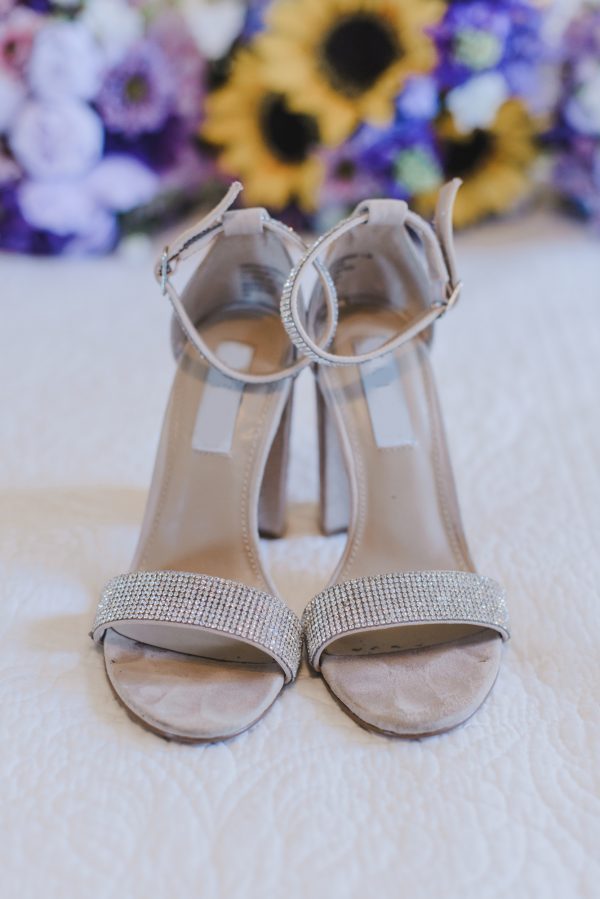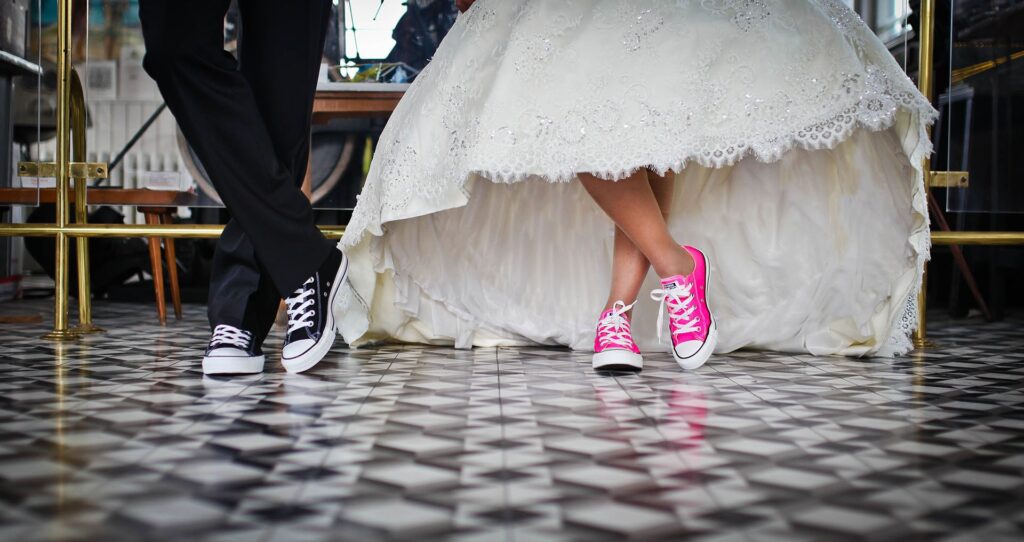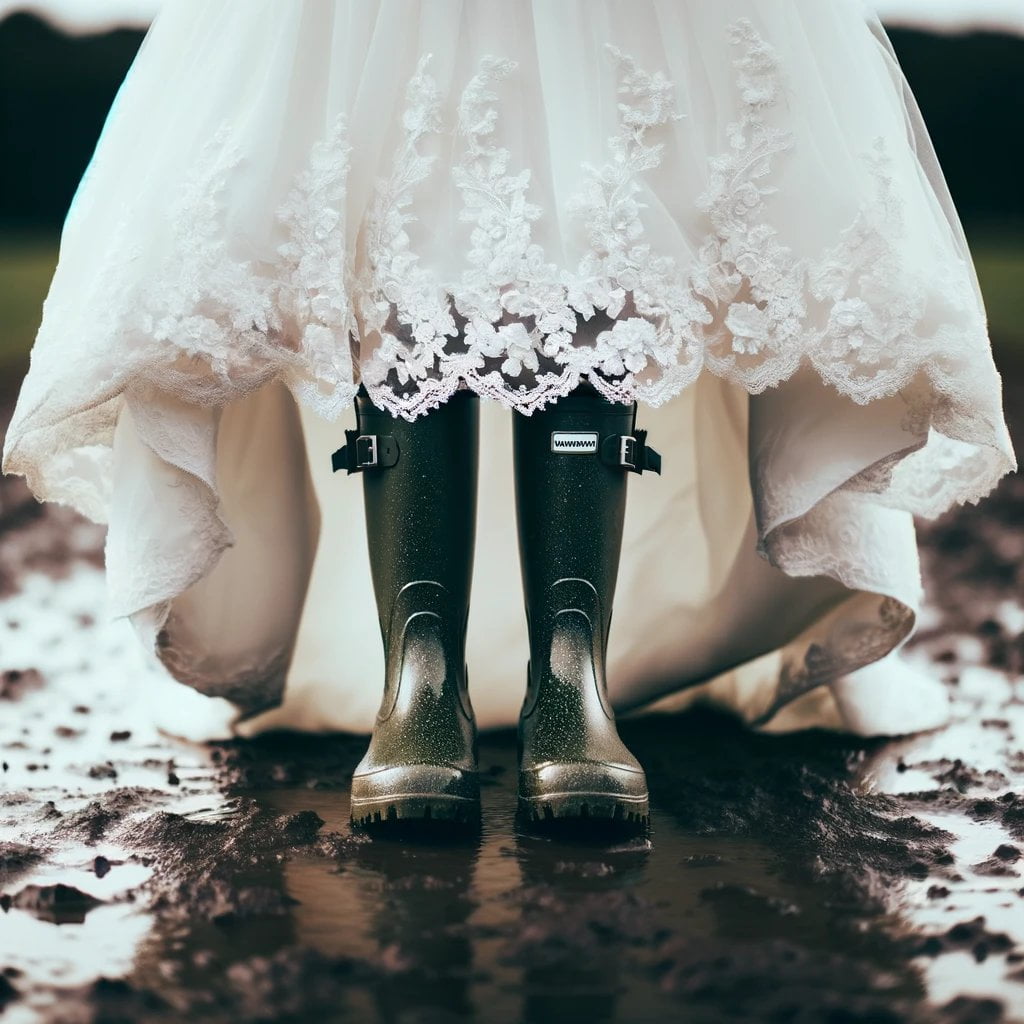DURING YOUR SPECIAL DAY, DO YOU DREAD THE IDEA OF YOUR FEET FEELING LIKE A HERD OF
ELEPHANTS HAVE STAMPED ALL OVER THEM?
Instead, do you want to find a way to feel like you’ve been wearing your comfiest slippers all day?
If you do, then read on for my 5 top tips to keep the blisters at bay.
Have you girls heard of the term ‘Wedding feet’? Yes, that’s a real thing!
Wedding feet are feet that have been crammed into uncomfortable wedding shoes for hours on end on your wedding day, leaving them sore and maybe covered in blisters.
Those brides that suffer from this cannot wait to rip those shoes off and scream with the relief.
Now I know when you think of shopping for your wedding shoes, the exciting part is thinking about the bling and how pretty they are, not can I dance in these until 1am?
Saying that, if you want to avoid ‘Wedding feet’, even though it’s not as exciting you have to consider the comfort side of things also.
When you think about the average wedding day, you’re wearing your shoes for around 12 hours and a lot of that involves walking or standing about.
Unless you have comfortable shoes on, each hour can make those toes feel worse. Eventually feeling like they’re in a vice.
Choosing wedding shoes isn’t an easy task at all, there’s so much to think about. They’ve got to be fabulous, but comfortable at the same time.
Over the years styles and what is considered acceptable have changed, these days it’s all about whatever suits you. It could even be a fancy wedding boot, not even a shoe!
So don’t restrict yourself to those 6-inch stilettos, read on for things to consider…
Your feet will thank you for it!
1 How high can you go?
Firstly girls, let’s be serious.
If you spend your life in trainers and want to go for something that makes you feel like you’re walking much taller, to begin with you’re going to find that uncomfortable no matter what. So consider what will be good for you? What is realistic?
Flat shoes or kitten heels are the most comfortable wedding shoes to wear. Try and stay with what you’re used to, or if you insist on going higher don’t go too much higher and practice, practice, practice walking in them.
If you don’t, this is a disaster waiting to happen. You may picture yourself gliding along like a swan and what it’ll look more like is you looking like a new-born giraffe on ice.
A high heel will push your weight forward onto the balls of your feet and if your feet are not used to this eventually the joints will become tender.
As well as the height, the width of the heel is important too. The same weight over a narrow heel is going to feel more uncomfortable than the same weight over a chunkier heel – that’s just physics.
Alongside this is the slope of the heel. Is it straight down, giving you more support or does it lean in towards the toes?
If you’re going for a sturdier heel, a wedge heel does not allow your foot to flex as you walk and move, which again can lead to foot pain and general unsteadiness when you’re wearing them, so a block heel would be better.
For those of us with weak ankles, a strapped shoe gives more support than a court shoe, so it’s worth taking that into account too.

2 Don’t forget the tootsies!
Okay after heel style, the next important thing to look at is the comfort of your toes.
Try on any potential wedding shoes whilst standing so that your full weight is on your feet, this will give you the chance to ensure that the width of the shoe around the toe area is enough to accommodate your toes properly.
Check that they are not crammed into too small a space and conversely the shoe is not too wide so that your toes can move about. This will leave you with less stability, but also the shoes may rub.
Also, look for your toes overhanging the front of the shoes. If this is the case you will need to reassess the size of shoe, or the position of your foot.
If the sizing is correct then it may be because you have a high heel and gravity is taking over and pushing your foot forward. If something is not done about it the back of your toes will become sore.
Something as simple as putting an insole in your shoe to stop the slipping could work, as long as this does not make your shoe too tight.
Or use body tape across the ball of your foot to create friction in your shoe and stop your foot slipping forward.
Some brides like to have the front platform part of the shoe thick to offset the difference in the heel height (see photo below), this can ease the pressure on the ball of the foot and make your feet so much more comfortable.
An old-wife’s tale that expert advice varies on, is the idea that strapping together your 3rd and 4th toes (your big toe is number 1) will help. The suggestion is that doing this provides support, protection and keeps the joints in line.
Old-wife’s tale or not, it might be worth a try.

3 Is the size correct?
Generally, once we have reached adult hood our feet do not grow larger, although they can change shape.
So, if you find that your wedding shoes are not feeling as good a fit as you would like, check the size.
If the size is correct, however the width is not quite right then you need to do something about that as this will cause problems.
If the shoe is too narrow, check out if they have a wider version of the shoe as some suppliers will stock these and if not they can order them for you.
If the shoe is too wide, then add in insoles or try body tape as already mentioned. If the shoe is too big in any way, then your feet must work extra hard at keeping them on your feet and they will end up feeling the strain and start to ache.
If like most brides, you cannot afford to have your wedding shoes handmade and you’re in between sizes, then get the next size up. Put in insoles to get them to fit better.
If your feet swell, then you can take out the insoles. If you’re wearing the smaller size, then you’re likely to end up in agony.
4. What’s the weather going to be like?
Think about the temperature around your wedding day.
If it’s going to be incredibly hot, then consider open-toed/heeled wedding shoes to let your feet breathe.
This will mean less swelling and so more comfort.
If you’re getting married in a cold climate then think of shoes to keep your feet cosy.
We don’t want ANY kind of cold feet on your wedding day. 😊
And if it’s going to be chucking it down, well…

5. Are you walking on solid ground?
Where is your wedding going to be held? Match the shoe most appropriate for that terrain.
Heels on beaches just doesn’t work, and if you’re going to be walking across grass in heels then think of getting heel protectors.
These will help you walk more steadily, stop you sinking, and protect your heels from grass stains.
Also, a bit of sound advice for new wedding shoes is to take some sandpaper and roughen up the bottom of your shoes.
This will help you to stop slipping on shiny dancefloors and similar surfaces.
If you don’t want to do that then have rubber soles and heels put on the bottom of your wedding shoes, as not only will this help you stop slipping, but it’ll also help to protect the bottom of your shoes also.
Last few tips…
Whatever style of wedding shoes you go for, buy them as soon as you can and wear them in beforehand.
Don’t just wear them on carpet, wear them on harder surfaces also to prepare your feet and get them used to walking in the shoe.
During your wedding day, try and sit down as much as possible, or even sneak off your shoes if you feel like it. You may be wearing your heels for around 12 hours which is a long time, even for a heel-wearing pro.
A change of footwear could be a good idea, even if only as a backup plan. You may not need them, however, it’s great to have them just in case.
These should be ultra-comfortable and preferably similar in height, so that you’re not tripping over your dress.
You can buy cushioned gel pads to put in your wedding shoes. These help to relieve the pressure from the balls of your feet and from the back of your shoes to stop them rubbing. These can be well worth the investment.
Even if you’re using gel pads, you must still ‘break in’ your wedding shoes before your big day. Trying wear them with socks on, to help them stretch.
In your wedding day ‘emergency bag’ ensure that you have plenty of plasters to cover all foot crises. Hopefully, these won’t be needed, however, you don’t want the shine taking of your day for want of a plaster.
Lastly, look after your feet leading up to your wedding day. Pamper them and have them ready to go on show to all your guests.
I hope that this has given you some food for thought. Looking after your feet on your wedding day is so important.
See you on the next blog, however if in the meantime you have any queries or fancy a chat about your wedding wishes then click the link below and leave your details and I’ll get back to you.
Bye for now,
Tracy
XxX




